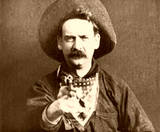First Silent Movie, The Great Train Robbery (1903): Produced by Thomas Edison but directed and filmed by Edison Company employee Edwin S. Porter, The Great Train Robbery was the first narrative movie, one that told a story.
The film is a classic western with four bandits who rob a train and its passengers of their valuables and then make their grand escape only to be killed in a shootout by a posse sent after them.
The film does not spare on violence as there are both several shootouts and one man being bludgeoned with a piece of coal. Surprising to many audience members was the special effect of throwing the bludgeoned man over the side of the train (a dummy was used). Also first seen in The Great Train Robbery was a character forcing a man to dance by shooting at his feet – a scene that has been often repeated in future westerns. To the audience’s fear and then delight, there was a scene in which the leader of the outlaws looks directly at the audience and fires his pistol at them. (This scene appeared either at the beginning or at the end of the film, a decision left up to the operator.)
The Great Train Robbery not only was the first narrative film, it also introduced several new editing techniques. Rather than staying on one set, Porter took his crew to ten different locations, including Edison’s New York studio, Essex County Park in New Jersey, and along the Lackawanna railroad. Unlike other film attempts which kept a stable camera position, Porter included a scene in which he panned the camera to follow the characters as they ran across a creek and into the trees to fetch their horses. However, the most innovative editing technique introduced in The Great Train Robbery was the inclusion of crosscutting. Crosscutting is when the film cuts between two different scenes that are happening at the same time.
The Great Train Robbery was hugely popular with audiences. The approximately twelve minutes of film that starred Gilbert M. “Broncho Billy” Anderson was played across the country in 1904 and then played in the first nickelodeons (theaters in which movies cost a nickel to see) in 1905. The Great Train Robbery’s popularity lead directly to the opening up of permanent movie theaters and opened up the possibility of a future film industry.

